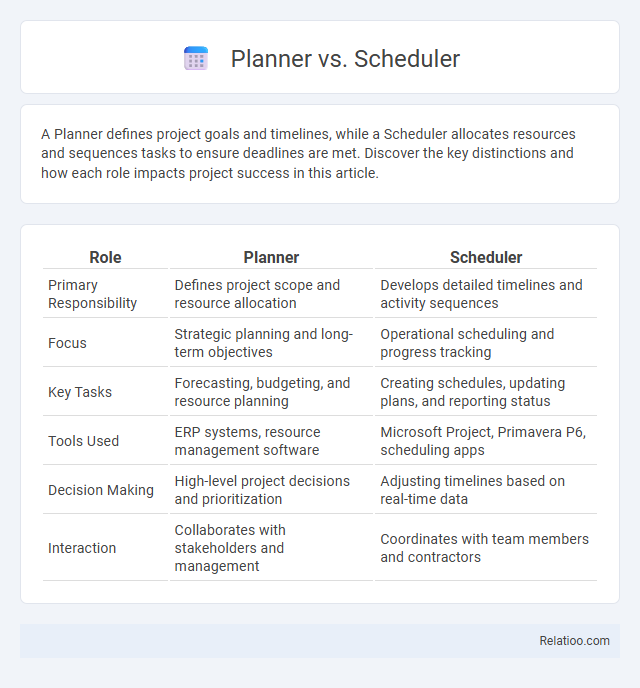A Planner defines project goals and timelines, while a Scheduler allocates resources and sequences tasks to ensure deadlines are met. Discover the key distinctions and how each role impacts project success in this article.
Table of Comparison
| Role | Planner | Scheduler |
|---|---|---|
| Primary Responsibility | Defines project scope and resource allocation | Develops detailed timelines and activity sequences |
| Focus | Strategic planning and long-term objectives | Operational scheduling and progress tracking |
| Key Tasks | Forecasting, budgeting, and resource planning | Creating schedules, updating plans, and reporting status |
| Tools Used | ERP systems, resource management software | Microsoft Project, Primavera P6, scheduling apps |
| Decision Making | High-level project decisions and prioritization | Adjusting timelines based on real-time data |
| Interaction | Collaborates with stakeholders and management | Coordinates with team members and contractors |
Introduction to Planner vs Scheduler
Planners and schedulers play distinct roles in project management and operations, where planners focus on defining project objectives, resources, and timelines, while schedulers concentrate on detailing task sequences and timelines to optimize workflow. Planners develop the strategic framework and allocate resources, setting the foundation for the scheduler to create detailed task schedules and manage dependencies. Understanding the differences between planners and schedulers enhances project efficiency by aligning high-level planning with practical execution timelines.
Defining a Planner and Its Functions
A planner is a strategic tool designed to organize tasks, set goals, and allocate resources efficiently within a project or workflow. Its core functions include identifying priorities, creating timelines, and monitoring progress to ensure optimal productivity. You can leverage a planner to enhance decision-making and streamline operations, distinguishing it from a scheduler, which primarily focuses on assigning specific times for tasks.
What is a Scheduler? Key Features
A scheduler is a software tool designed to automate and manage the allocation of resources, tasks, and timelines to ensure efficient project execution. Key features of a scheduler include task prioritization, real-time progress tracking, and conflict resolution to optimize workflow and deadlines. By using a scheduler, you can streamline operations, reduce delays, and improve overall productivity in complex projects.
Core Differences Between Planner and Scheduler
Planners primarily focus on setting long-term goals, defining project scope, and allocating resources to create a strategic roadmap, while schedulers concentrate on breaking down the plan into specific tasks, assigning timeframes, and managing daily execution to meet deadlines. The core difference lies in planners addressing the "what" and "why" of a project, whereas schedulers address the "when" and "how" to ensure timely progress. Effective project management requires seamless integration between planning and scheduling to optimize resource utilization and achieve project milestones.
Use Cases: When to Use a Planner
A planner is ideal for long-term project management, helping teams map out tasks, allocate resources, and set deadlines to ensure strategic goals are met efficiently. In scenarios requiring high-level coordination and timeline visualization, such as product development or event organization, planners streamline workflow and task prioritization. Unlike schedulers, which manage day-to-day task timing, planners focus on broader project milestones and resource planning.
Use Cases: When to Use a Scheduler
Schedulers are essential when managing complex workflows that require precise timing, resource allocation, and dependency handling to optimize operational efficiency. Your best use case for a scheduler involves automating repetitive tasks, coordinating job execution across distributed systems, and ensuring critical processes run at specific intervals without manual intervention. Unlike planners, which focus on strategizing and outlining actions, schedulers execute those plans in real-time, making them vital for time-sensitive production environments and IT system maintenance.
Benefits of Using a Planner
Using a planner enhances your productivity by organizing tasks and deadlines in a clear, manageable format, reducing stress and preventing missed appointments. It provides a structured approach to time management, enabling you to prioritize activities and allocate resources efficiently. Your overall goal achievement improves as a planner helps track progress and maintain focus on key objectives.
Advantages of Schedulers in Time Management
Schedulers enhance time management by efficiently allocating resources and prioritizing tasks based on deadlines and dependencies. Your workflow benefits from real-time adjustments, ensuring optimal productivity and reduced downtime. Advanced scheduling tools also provide data-driven insights, allowing for better forecasting and improved decision-making.
Integration: Combining Planner and Scheduler
Combining Planner and Scheduler enhances project management by integrating task planning with detailed scheduling, ensuring seamless workflow execution. Your team benefits from real-time updates, resource allocation, and deadline synchronization, promoting efficiency and reducing delays. This integration enables centralized control, allowing you to monitor progress and adjust plans dynamically for optimal project outcomes.
Choosing the Right Tool for Your Needs
Selecting the right tool between a Planner and a Scheduler depends on the project's complexity and timeline requirements. Planners excel at outlining overarching goals and strategic milestones, while Schedulers provide detailed task allocation and time management for daily operations. Understanding your project's scale and workflow will guide you to use Planners for high-level planning and Schedulers for precise, time-based execution.

Infographic: Planner vs Scheduler
 relatioo.com
relatioo.com